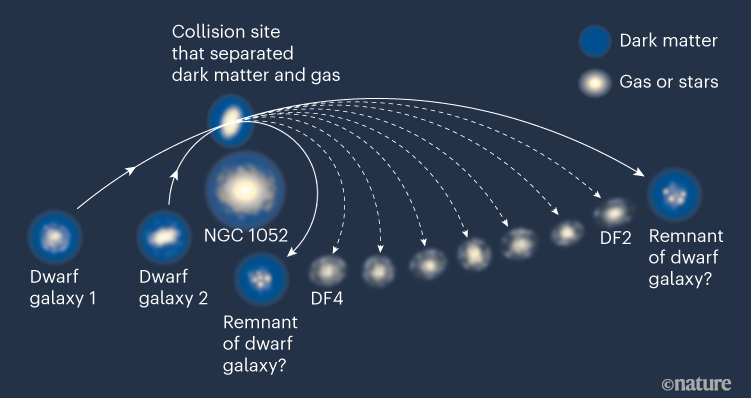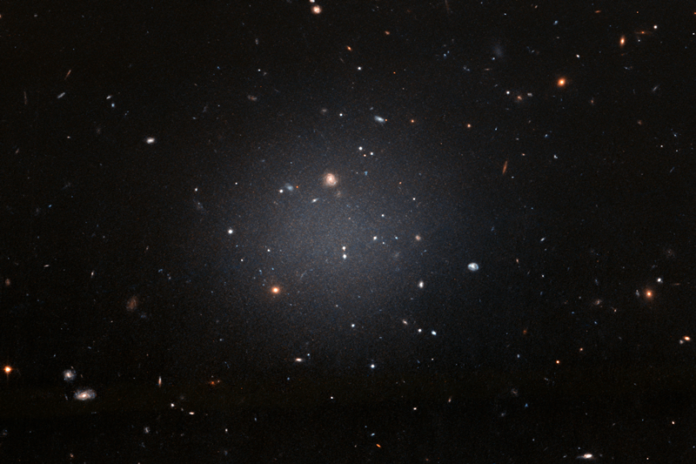If you look up at the sky on a clear night outside of the city, our galaxy seems to be filled with stars. And while there are more than 100 billion stars throughout the Milky Way galaxy, they actually only account for a small fraction of our galaxy’s total mass. The rest — about 90% — is made up of a mysterious material called dark matter.
Astronomers believe that most galaxies contain large amounts of dark matter. A few years ago, however, a team of astronomers found a galaxy that didn’t appear to have any dark matter at all. This puzzling discovery threw our understanding of the universe into question.
Now, those same astronomers believe that they may have found a way to explain how some galaxies can form without any dark matter. The study included contributions from Roberto Abraham, a Professor and Chair of the David. A Dunlap Department of Astronomy & Astrophysics at the University of Toronto, and was published in Nature.
Why do galaxies contain dark matter?
Dark matter makes up 27% of the Universe and 90% of the Milky Way galaxy, but astronomers still aren’t totally sure what it is. What we do know is that it can interact through the force of gravity, but that it does not interact through the electromagnetic force. This means that it doesn’t absorb, reflect, or emit any light, and isn’t subject to forces such as friction.
Although we can’t see dark matter directly, we know that it’s present in our galaxy (and many others) because we can see the effects it has on our stars. Stars in the farthest reaches of our galaxy move much faster than we expected, meaning that there must be some additional source of gravity out there which we can’t observe.
Astronomers now believe that dark matter is important in helping galaxies form. Large amounts of dark matter clump together, and their gravitational force attracts dust and gas, which eventually goes on to birth stars.
This is why astronomers were so surprised when they first spotted a dark-matter-free galaxy with the Dragonfly Telephoto Array in 2018. The stars in this galaxy moved so slowly that dark matter couldn’t be affecting their orbits.
And although some astronomers doubted this first observation, the discovery of a similar galaxy soon after made it clear: some galaxies don’t appear to have any dark matter at all.
How could a galaxy form without dark matter?
Although these two discoveries of dark-matter-free galaxies initially seemed coincidental, the team behind the discoveries decided to ask whether they might be related.
After studying the speeds and trajectories of the two galaxies, the astronomers realized that they were moving away from each other. If you trace their trajectories billions of years backwards in time, this means they might have once been at the same location.
The galaxies’ speeds were fast enough to tell the astronomers that they didn’t just pass by each other billions of years ago: they collided. This historical collision gave the astronomers an idea about how the galaxies could have been left without any dark matter today.
Regular matter (like gas) is subject to both electromagnetic and gravitational forces, whereas dark matter only interacts gravitationally. This means that this ancient collision could have resulted in vastly different outcomes for the different components of the two galaxies.
The result would be that the dark matter continues moving apart, while the regular matter is significantly slowed down by extra electromagnetic forces like friction and gets left behind — resulting in dark-matter-free galaxies.
To test this idea, the team looked for evidence in between the two dark-matter-free galaxies. A collision like this would have produced a trail of material in between the original galaxy remnants. And sure enough, the researchers were able to observe a long trail of dark-matter-free material right where they expected.

The researchers also searched for the dark-matter-dominated galaxies that they expected to be located at the very edges of the dark-matter-free trail. They identified two possible candidates, but will need more observations to be sure that they’re really there.
“There are these new galaxies with almost no dark matter, and then there are two objects at the leading edge of the row that we think may be the remnants of dark matter from the original galaxies,” explained Pieter van Dokkum, a Professor of Astronomy at Yale University and lead author of the study, in a press release.
“We’re seeing the entire aftermath of this collision, laid out in the sky. Everything fits now.”
Going forward, these results will help astronomers understand one of the most puzzling discoveries in their field.
Galaxies shouldn’t be able to form without dark matter, but with the help of ancient collisions, these seemingly impossible objects were able to emerge.









































